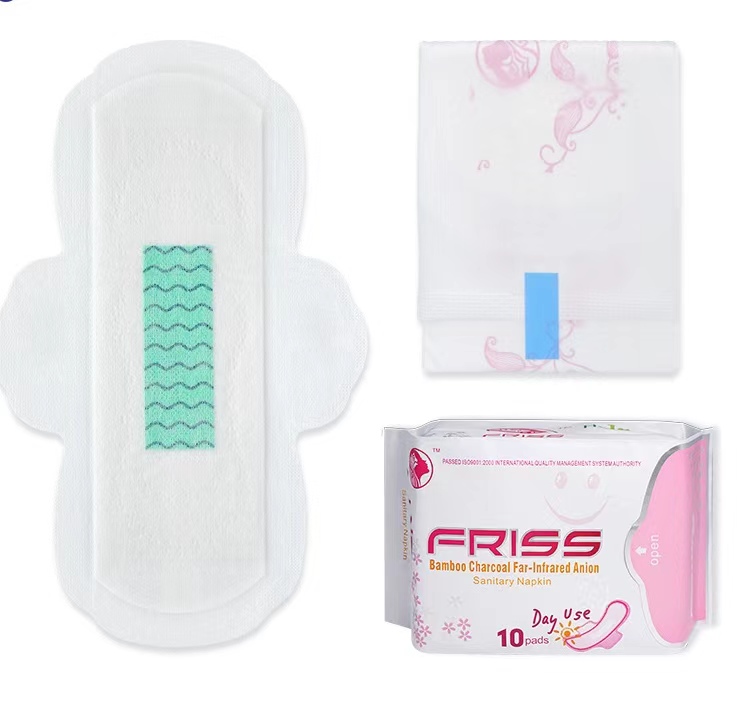Your cart is currently empty!
The composition of sanitary napkin materials

A brief introduction to sanitary napkin products
Sanitary napkins can be divided into three categories based on the surface material:
A Dry mesh sanitary napkins refer to sanitary napkins whose surface layer is made of various perforated films, mainly polyethylene, commonly known as PE film;
B Cotton soft sanitary napkins refer to sanitary napkins whose surface layer is made of various non-woven fabrics, mainly polypropylene, commonly known as PP
C Pure cotton sanitary napkins refer to sanitary napkins whose surface layer is made of pure cotton materials, mainly pure cotton non-woven fabrics.
About the structure of sanitary napkins
There are a total of 3 layers, from top to bottom, namely the surface layer, the absorption layer, and the bottom film.
The first layer
Surface layer: close to the skin. Menstrual blood penetrates the surface layer and seeps into the absorption layer.
The core material of the surface layer is 2 categories: plastic and pure cotton
a. Plastic surface layer
Common dry surface layer, polyethylene (PE). The production process is similar to plastic film.
Cotton soft surface layer, polypropylene (PE). The production process is a non-woven fabric process. The surface layer of masks and common wet wipes are made of this material.
b. 100% cotton, made of pure cotton non-woven fabric
Other existing but rare surface materials include:
a. Hemp, a natural hemp fiber. It has a little antibacterial effect, but it feels a little rough.
b. PLA, polylactic acid. Corn starch, after a series of chemical reactions, becomes PLA, which can be made into a film. Biodegradable plastic bags are now basically produced by mixing PLA and PBAT. PLA is plant-based and degradable. It has been very popular in the past 10 years, but it also has some limitations.
c Silk, which has biocompatibility and can reduce allergies in private parts
The second absorption layer
The absorption layer can be subdivided into many layers. But no matter how it is divided, it is to serve one goal: absorbing menstrual blood.
The materials of the absorption layer are basically the following two:
a. Fluff pulp
b. High molecular absorbent resin (SAP)
The combination of these two materials has derived some new composite materials, such as: dust-free paper*.
The absorption capacity of sanitary napkins depends on the amount of SAP added. In the past 20 years, there has been no fundamental breakthrough in the materials of sanitary napkins, so companies have begun to compete with each other to see who absorbs more, who absorbs faster, and who is the driest. These are all determined by: which layer of the sanitary napkin is SAP placed on, and how much is placed. SAP is a polymer chemical. In principle, even if it contacts the skin, it will not have any effect. What will happen if it contacts for a long time? This research has not been done and is currently unknown. From the structure of the sanitary napkin, SAP will not directly contact the skin. SAP absorbs liquid and can lock in liquid. It is the key raw material for sanitary napkins and diapers. The problem with SAP may be the amount. How much is appropriate to use? ! We have been exploring this issue for several years and are still exploring it. People who are interested can discuss it together.
The raw materials used for the absorbent core of the other two types of sanitary napkins are different from those of regular sanitary napkins.
- Organic cotton sanitary napkins use organic cotton as the absorbent core, which absorbs water but cannot lock it.
- Liquid sanitary napkins use FlexFoam, a patented new chemical material that can both absorb and lock it.
The third layer, the bottom film
The bottom film, as you can all feel, is a layer of plastic. The material of this layer of plastic is the same as the surface layer of the dry mesh, polyethylene PE. Although the raw materials are both PE, the processes are different, and two films that look completely different are made. The past, present, and future of plastics are a very interesting topic that is closely related to everyone. Let’s dig a hole here first, and if there is a chance later, invite some industry experts to write about the development prospects of environmentally friendly plastics.
The reason why sanitary napkins are called the source of serious white pollution is that the core lies in this bottom film and the plastic film used for single-piece packaging. Some single-piece packaging bags for sanitary napkins look like non-woven fabrics, but many people think they are cotton or paper. Please pay special attention to the fact that these non-woven fabrics are also a kind of plastic.
The base film materials of the other two types of sanitary napkins are as follows.
a. Organic cotton sanitary napkins certified by GOTS use 100% biodegradable film. There are clear regulations in the organic certification standards.
b. Liquid sanitary napkins, like regular sanitary napkins, use plastic.
Other auxiliary materials of sanitary napkins
a. Hot melt adhesive: sanitary napkins are multi-layer structures and must be bonded with hot melt adhesive. The amount of adhesive used is very small, but it is indispensable in the current sanitary napkin production technology. Hot melt adhesive is a resin that is solid at room temperature and becomes liquid at 120-160 degrees. It is sprayed into filaments for bonding. In principle, resin is also a polymer chemical that is non-toxic at room temperature and will not irritate the skin. However, among the people with sanitary napkin allergies we have come into contact with, 2 cases are highly suspected of being allergic to a substance in the hot melt adhesive.
b. Release paper: The piece of paper torn off when using sanitary napkins. This piece of paper is a composite material, coated with a layer of silicone oil to achieve the isolation function.
c. Each piece of independent packaging film: Most brands use plastic. A small amount of plastic and paper laminated composite paper is used. Organic cotton sanitary napkins must use 100% biodegradable plastic.
Finally, let’s make a summary. In conventional sanitary napkins, the following materials must be used:
a. Plastic
b. Fluff pulp
c. Cotton (possible, not necessary)
d. SAP
e. Hot melt adhesive
f. Release paper

Leave a Reply